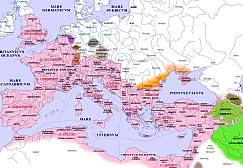

An Online Encyclopedia of Roman Emperors
Silvanus (355 A.D.)
Michael DiMaio, Jr.
Salve Regina University
Claudius Silvanus was both a Christian and a Frank. Born in Gaul, he was the son of the Frankish general Bonitus, who aided Constantine I in the war against Licinius. In 351, as a tribune he had surrendered to Constantius II at the Battle of Mursa. When Magnentius' revolt ended in late 353, the Germans continued to raid the province of Gaul. Constantius dispatched Silvanus, as commander of the Gaulic army, to expel the Germans from the province. The emperor appointed the former magister militum toward the end of 352 or the beginning of 353. Silvanus allegedly bribed the Germans with revenues that he had collected.
His success in Gaul, however, did not win favor at court; a plot was formulated against him by Dynamius, who had the helpof Lampadius, the Praetorian Prefect, Eusebius, Count of the Privy Purse, and Aedesius, the magister memoriae, Having tampered with documents Dynamius had received from Silvanus, these individuals easily convinced the emperor that Silvanus desired to be emperor and was starting a rebellion. Constantius II fell into their trap, and orders were issued for the recall of Silvanus.
Apodemius carried this order to Gaul; instead of carrying out his orders, he attempted to interrogate some of Silvanus' slaves and friends, to obtain an admission of guilt from them. When Constantius discovered the plot, he ordered an investigation leading to the punishment of one individual who pleaded guilty. Finding himself in an untenable position, Silvanus declared himself emperor at Colonia Agrippina on 11 August 355. He was driven to this action because he heard that his own men would put him to death or sell him to the emperor.
When Constantius, at Mediolanum (Milan), received the news about the revolt of Silvanus, he called a meeting of his consistory and dispatched Ursicinus to Gaul with a letter naming him as Silvanus' successor. When the general arrived a Colonia Agrippina, he was well received; the letter he carried simply ordered Silvanus to return to Mediolanum and contained no evidence that the emperor knew of the revolt. Although Silvanus hoped that his replacement would support him, Ursicinus, by means of bribes, was able to win over the auxilia; some of them put Silvanus to death while he was on his way to a Christian service at dawn on 7 September 355; he had been in power for twenty-eight days.
Barnes, T.D, Athanasius and Constantius: Theology and Politics in the Constantinian Empire, Cambridge, 1993.
Jones, A.H.M. J.R. Martindale, and J. Morris. "Silvanus 2" the Prosopography of the Later Roman Empire, Cambridge, 1971, 1.840-41
Kienast, Dietmar. Römische Kaisertabelle: Grundzüge einer römischen Kaiserchronologie. Darmstadt, 1990.
Nutt, D.C. "Silvanus and the Emperor Constantius II." Antichthon 7 91973): 80ff.
Seeck, O. "Constantius (4)." RE 4: col. 1044ff.
Comments to: Michael DiMaio, Jr.
Updated: 6 August 1996
For more detailed geographical information, please use the DIR/ORBAntique and Medieval Atlas below. Click on the appropriate part of the map below to access large area maps.
